Which is the best month for Chandrashila trek?
Published on October 28, 2025
When it comes to exploring the Himalayas, few experiences match the magic of the Chopta Chandrashila Trek. Nestled in Uttarakhand’s Garhwal region, this trail takes you through dense forests, peaceful meadows, and up to the magnificent Chandrashila summit — a point where the entire Himalayan range unfolds before your eyes. But before you lace up your trekking boots, choosing the right time to visit is what truly defines your adventure.
For travelers planning a Chopta tour package from Delhi, timing plays a crucial role in shaping the overall journey. The months you pick determine whether you’ll trek under blooming rhododendrons, walk across snow-laden paths, or enjoy crystal-clear mountain views. Each season transforms Chopta in its own way — from the colorful spring to the serene winters.
A well-planned Chopta tour package ensures that your trek isn’t just about reaching the summit but about savoring every step of the journey — from the scenic drives through Rishikesh and Ukhimath to the peaceful nights under a sky full of stars. If you’re embarking on the Chopta Chandrashila Trek from Delhi, understanding the best month to go helps you experience the trek at its most beautiful and comfortable phase.
Whether you seek the adventure of snow trekking, the freshness of mountain blooms, or the calm of misty monsoon mornings, picking the perfect season transforms your Chopta tour into a memory that stays forever. Timing, after all, is the key to unlocking the true spirit of Chandrashila.

Spring (March to May): The Best Season for the Chopta Chandrashila Trek
Spring breathes new life into the mountains of Chopta. From March to May, the trails come alive with the fragrance of blooming rhododendrons, lush meadows, and clear skies that stretch endlessly above the Himalayas. This is the season when the Chopta Chandrashila Trek from Delhi becomes a perfect blend of beauty and comfort — the weather is mild, the skies are blue, and the mountains stand tall without the harshness of snow or the uncertainty of rain.
If you’ve dreamed of experiencing the Chopta Tungnath Trek, spring is the ideal time. The route to Tungnath Temple — the highest Shiva temple in the world — opens up beautifully during these months, offering trekkers a chance to walk through vibrant alpine forests and witness panoramic views of Nanda Devi, Trishul, and Chaukhamba peaks. The meadows shimmer in green and gold as the snow from winter begins to melt, creating a magical landscape that feels almost unreal.
As you ascend towards Chandrashila, the weather remains pleasantly cool, making the climb comfortable and rewarding. The Chandrashila summit trek during spring is especially breathtaking — the sunrise here paints the Himalayan skyline in shades of gold, pink, and orange, a view that leaves every traveler speechless.
For those starting their journey with a Chopta Chandrashila Trek from Delhi, spring ensures smooth travel, easy road access, and picture-perfect conditions for photography and camping. Whether you’re seeking adventure, spiritual calm at Tungnath, or the simple joy of walking amidst blooming hills, spring truly offers the best version of the Chopta experience.
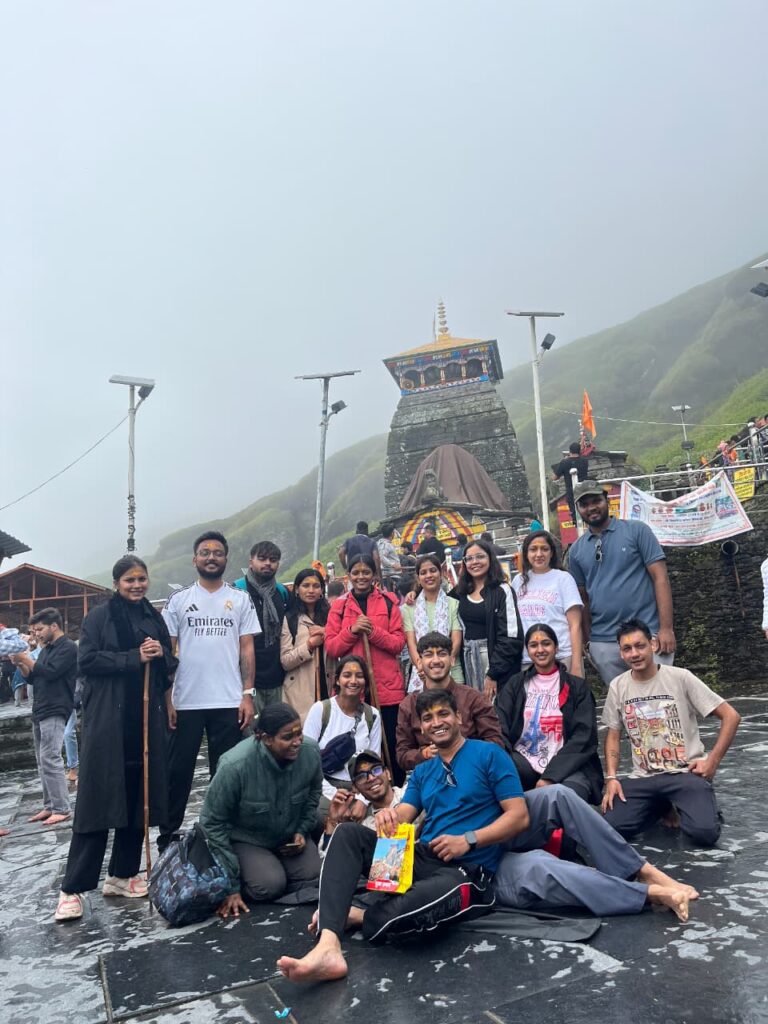
Winter Wonderland (December to February): Snow Lovers’ Paradise
When winter arrives, Chopta transforms into a glistening white paradise. From December to February, the entire valley and trail are covered in a thick blanket of snow, turning the Chopta Chandrashila Trek into a true Himalayan winter adventure. For trekkers who love the thrill of walking through snow-covered forests and frozen meadows, this is the season to experience pure magic.
The Chopta Tungnath Trek during winter feels like stepping into a snow globe — pine trees heavy with snow, frozen streams glistening under sunlight, and the distant peaks shining like diamonds. Though the path to Tungnath Temple may be partially buried under snow, the journey becomes even more enchanting. The crisp mountain air and the silence of the snow-covered surroundings create a sense of peace that’s hard to find elsewhere.
Reaching the Chandrashila summit trek in winter is challenging but incredibly rewarding. As you stand at the top, surrounded by an endless panorama of snow-draped Himalayan peaks, the effort feels worth every step. The sunrise over Chandrashila in winter is especially stunning — golden rays reflecting off the white landscape create a view straight out of a dream.
If you’re planning the Chopta Chandrashila Trek from Delhi, winter offers an unforgettable experience for those who crave adventure and solitude. Roads remain accessible till Chopta, and with the right gear, trekking through snow becomes an exhilarating experience. For snow lovers and photographers, this is undoubtedly the best time to explore Chopta’s serene and untouched beauty.
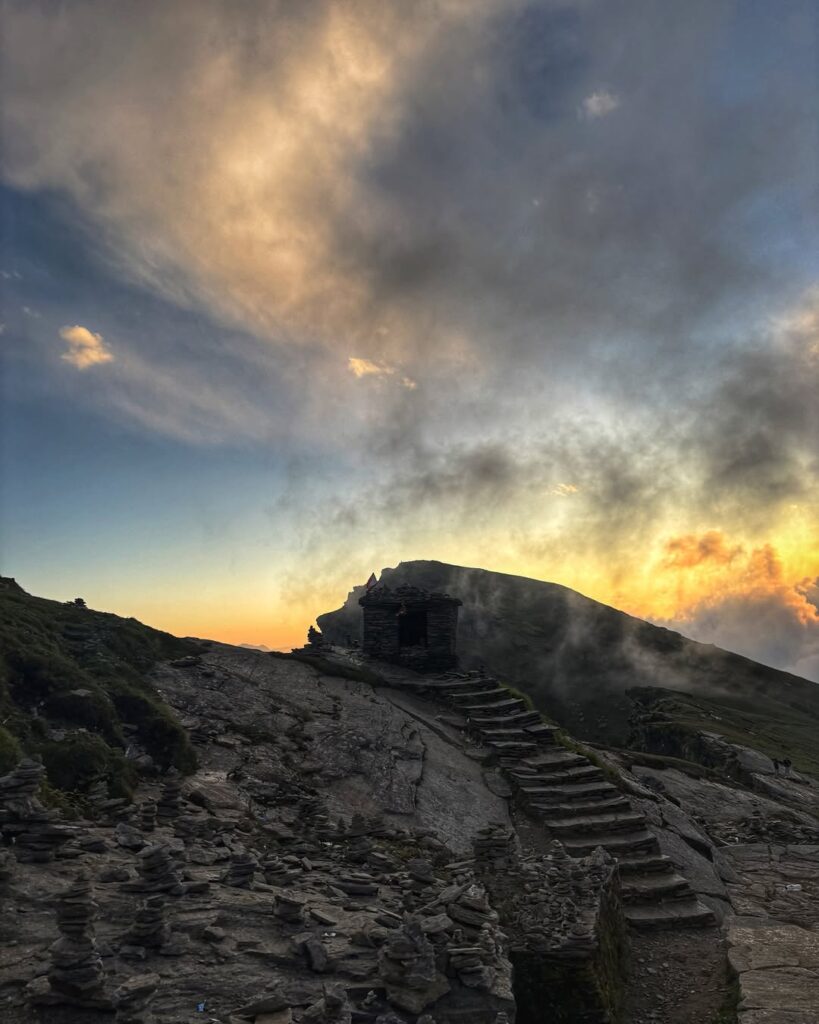
Autumn (September to November): Crystal Views and Calm Trails
Autumn in Chopta is a season of unmatched clarity and calm. From September to November, the monsoon clouds drift away, revealing deep blue skies and strikingly clear mountain views. The trails are dry, the weather is crisp, and the forests shimmer in hues of gold and green — making this the perfect time for the Chopta Tungnath Trek from Delhi.
During these months, the Chopta temperature stays pleasantly cool, ranging between 10°C during the day and 2–5°C at night. This mild weather makes trekking comfortable and ideal for both beginners and experienced hikers. You can walk easily through the pine and rhododendron forests without the challenge of snow or rain, enjoying the peace and solitude that autumn brings.
The Tungnath Temple trek is particularly special during this time. With the temple open and fewer crowds on the trail, you can truly feel the spiritual energy of the Himalayas. The crisp air carries the sound of temple bells, and every turn of the path offers a stunning view of the surrounding peaks — Chaukhamba, Trishul, and Nanda Devi glowing under the post-monsoon sunlight.
As you move higher toward Chandrashila, the trail rewards you with some of the clearest panoramic views of the Himalayas all year round. For those planning a Tungnath trek from Delhi, autumn offers the perfect blend of peaceful weather, open trails, and breathtaking scenery. It’s the season where every sunrise feels sharper, every step feels lighter, and every moment feels perfectly in tune with the mountains.
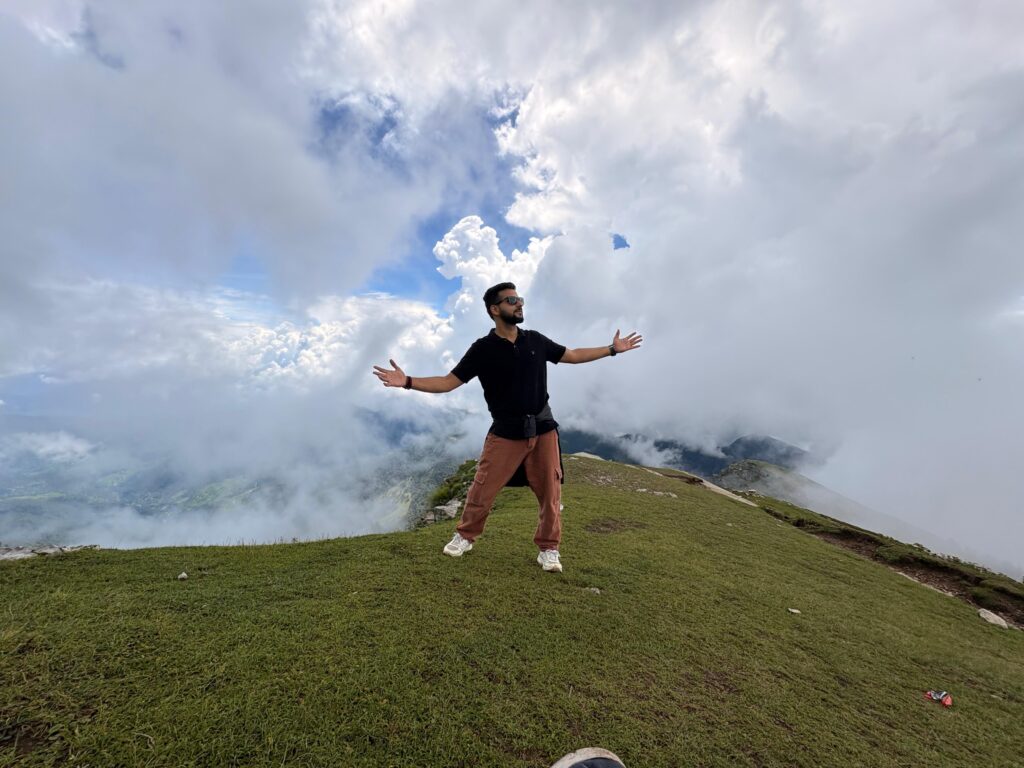
Monsoon Months (July to August): Should You Trek Then?
The monsoon season in Chopta, stretching from July to August, brings a completely different side of the Himalayas — one wrapped in mist, drenched in rain, and alive with vibrant greenery. The forests glow in shades of deep emerald, and waterfalls gush down the hillsides, making the region look like a scene from a fairytale. However, this is also the most unpredictable time for the Chopta Tungnath Trek and Tungnath Temple trek.
During monsoon, the Chopta temperature stays moderate, hovering between 12°C and 20°C. While the cool weather feels refreshing, heavy rainfall often leads to slippery trails and landslides in some stretches, especially for those traveling from Rishikesh or Ukhimath. Trekking during this season requires extra caution and proper gear, as the path to Tungnath Temple can become muddy and challenging.
That said, for travelers who enjoy solitude, monsoon brings a rare charm. The Chopta Chandrashila trek from Delhi during this period is quiet and serene — the crowds disappear, the forests breathe freely, and the smell of rain-soaked earth fills the air. The clouds drift across the peaks, creating fleeting glimpses of the Himalayas that feel almost mystical.
If you’re an adventure enthusiast who doesn’t mind getting wet and wants to see Chopta at its most lush and alive, monsoon can be a rewarding experience. But for clear views and easier trekking conditions, it’s usually better to plan your Tungnath trek before or after the rains. Monsoon in Chopta is beautiful, but it’s best suited for those who trek for the journey, not just the destination.
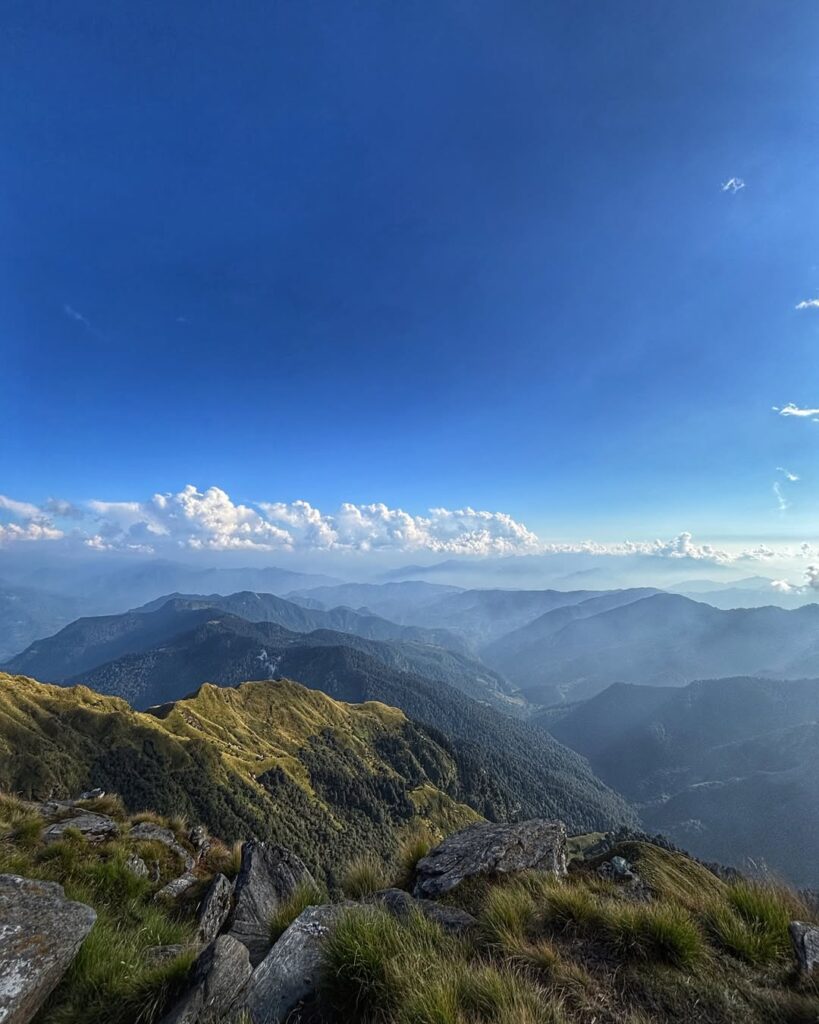
Choosing the Right Time for a Chopta Tour Package from Delhi
When planning your Chopta tour package from Delhi, timing is everything. The beauty of Chopta changes dramatically with every season — from snow-covered winters to blooming springs and crystal-clear autumn skies. Choosing the right month not only enhances your trekking experience but also ensures comfort, safety, and the perfect balance between adventure and relaxation.
For travelers seeking a refreshing escape, March to May offers the most scenic version of the Chopta Chandrashila Trek. The weather stays pleasant, and the roads from Delhi to Chopta remain clear, allowing smooth travel. This is the ideal time to visit Tungnath Temple and enjoy the colorful meadows and forest trails that lead up to Chandrashila.
If you’re an adventure lover looking to conquer snow trails, December to February is the season to go. The Chopta Tungnath Trek in winter gives you a true Himalayan experience — frozen streams, snow-dusted trees, and the tranquil silence of white landscapes. Just be prepared with warm layers and winter trekking gear for the journey.
For those who prioritize clear skies and unmatched views, September to November is perfect. The Chopta temperature is mild, the trails are calm, and you can enjoy the best visibility of the Himalayan peaks.
Each season offers a unique version of Chopta’s charm — and that’s the beauty of planning your Chopta tour package from Delhi. Whether you crave snowy adventure, spiritual calm at Tungnath, or peaceful nights under starlit skies, picking the right time ensures your journey becomes more than just a trip — it becomes a lifetime memory.

Seasonal Highlights: Weather, Views, and Trekking Comfort
Each season paints Chopta and Chandrashila with its own colors, moods, and experiences. To help you plan your adventure smartly, here’s a step-by-step seasonal breakdown of what to expect — from weather conditions to trekking comfort — especially if you’re preparing for the Chandrashila trek or the Tungnath Chandrashila trek from Delhi.
Spring (March to May) – Blooming Meadows and Clear Skies
-
Weather: Pleasant and cool, with temperatures between 10°C and 20°C.
-
Views: The sky is clear, offering stunning Himalayan panoramas. Rhododendrons paint the forests in pink and red.
-
Trekking Comfort: Ideal for beginners. Dry trails, mild climate, and easy accessibility from Delhi.
-
Experience: Perfect time to explore nature’s colors and visit the Tungnath Temple without extreme weather conditions.
Step 2: Summer (June) – Calm Before the Monsoon
-
Weather: Mildly warm during the day, with temperatures around 18°C to 25°C.
-
Views: Crisp visibility with green landscapes and fewer clouds.
-
Trekking Comfort: Comfortable but slightly humid; good for photography and camping.
-
Experience: Great for travelers starting the Tungnath Chandrashila trek from Delhi before monsoon rains arrive.
Monsoon (July to August) – Misty and Magical, Yet Risky
-
Weather: Frequent rains, temperature around 12°C–20°C, misty surroundings.
-
Views: Lush green valleys, flowing waterfalls, and dramatic clouds wrapping around the peaks.
-
Trekking Comfort: Slippery trails and limited visibility; not ideal for beginners.
-
Experience: Suitable only for seasoned trekkers who enjoy solitude and raw Himalayan beauty.
Autumn (September to November) – Crystal Clarity and Golden Forests
-
Weather: Cool and stable, ranging from 8°C to 18°C.
-
Views: Post-monsoon clarity makes this the best time for the Chandrashila trek — every mountain peak looks razor-sharp.
-
Trekking Comfort: Excellent. Dry trails, minimal crowds, and ideal for long hikes.
-
Experience: A dream season for trekkers and photographers seeking peaceful, scenic routes.
Winter (December to February) – Snow-Covered Serenity
-
0b Views: Magical snow vistas, frozen lakes, and white meadows stretching endlessly.
-
Trekking Comfort: Demanding but rewarding. You’ll need proper winter gear and guidance.
-
Experience: The Tungnath Chandrashila trek from Delhi in winter is a snow lover’s dream — challenging yet soul-stirring.
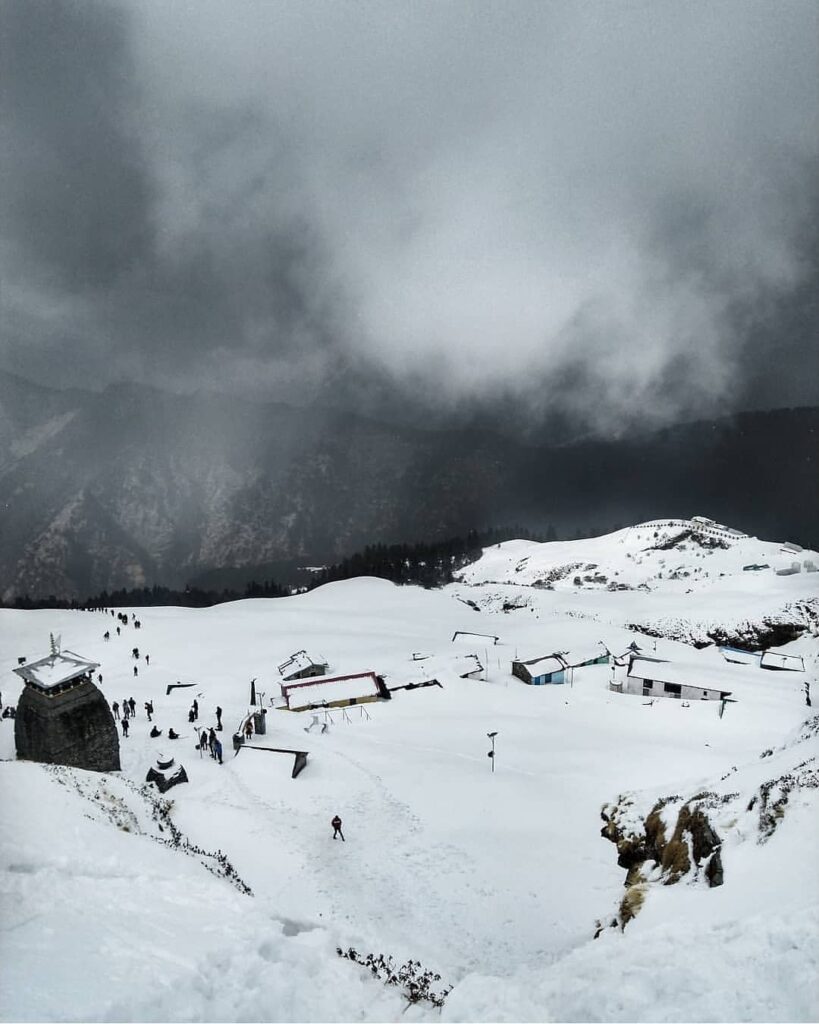
When to Witness the Best Sunrise at Chandrashila Peak
Catching the sunrise at Chandrashila Peak is one of the most breathtaking experiences in the entire Himalayas. Watching the first light of day paint the snow-clad peaks in golden hues feels nothing short of divine. But the real magic lies in choosing the right time to witness this unforgettable moment — both in terms of season and timing during your Chandrashila trek or Tungnath Chandrashila trek from Delhi.
1. Best Season for Sunrise Views
The most stunning and crystal-clear sunrise views appear during spring (March–May) and autumn (September–November).
-
In spring, the air is fresh, the sky is clear, and rhododendrons bloom all around, adding color to your morning trek.
-
In autumn, post-monsoon clarity ensures razor-sharp mountain views — perfect for photographers and sunrise chasers.
These months also provide stable weather, making it easier and safer to start your early morning ascent from Tungnath to Chandrashila.
2. Ideal Time to Start the Trek
To catch the sunrise, start your Tungnath Chandrashila trek around 3:30–4:00 AM from Chopta (or 4:30–5:00 AM from Tungnath). This gives you enough time to climb the steep final stretch before dawn. Reaching the summit just as the first light breaks will reward you with one of the most awe-inspiring scenes of your life.
3. What Makes Chandrashila’s Sunrise Special
As the sun rises, the peaks of Chaukhamba, Nanda Devi, Trishul, and Kedar Dome light up one by one — their golden glow mirrored in the clouds below. The silence of the mountains, broken only by the cold wind, makes this a deeply spiritual moment. It’s not just a view; it’s a feeling that stays with you long after the trek ends.
4. For Travelers from Delhi
If you’re planning the Chandrashila trek from Delhi, align your travel days so you reach Chopta one evening before your summit attempt. This gives you enough rest to start the early morning climb refreshed and ready. The clear skies of spring and autumn ensure you’ll witness the sunrise in its full splendor.
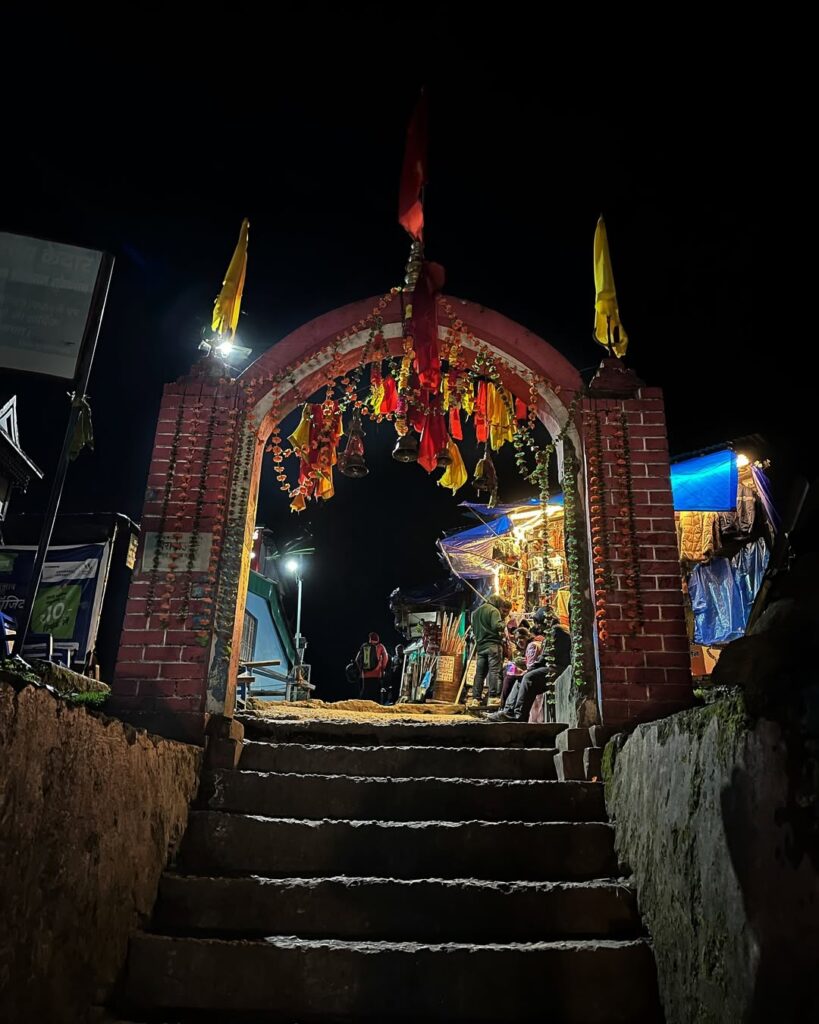
Finding the Perfect Month for Your Chandrashila Summit Trek
Choosing the perfect month for the Chandrashila Summit Trek is the key to experiencing the Himalayas at their finest. Each season brings its own magic — from snow-kissed trails to golden sunrises — making this one of the most captivating Himalayan adventures.
If you’re seeking the ideal balance of beauty, comfort, and accessibility, March to May (spring) and September to November (autumn) are the best times to go. In spring, the forests bloom with vibrant rhododendrons, and the crisp air adds a sense of freshness to every step. Autumn, on the other hand, offers crystal-clear skies and breathtaking mountain panoramas — a paradise for photographers and nature lovers alike.
For thrill-seekers, winter (December to February) transforms the trek into a true snow adventure. The Chandrashila Summit Trek during this season is a dream for snow lovers — challenging yet deeply rewarding, with the Himalayas shining in all their frozen glory.
If you’re starting your Chopta Chandrashila trek from Delhi, these months promise smooth travel, comfortable stays, and the best mountain visibility. Pairing your journey with a well-designed Chopta tour package from Delhi ensures a seamless experience — from reaching Tungnath Temple to witnessing sunrise from Chandrashila’s peak.
In the end, the perfect month for your Chandrashila trek isn’t just about ideal weather; it’s about connecting with the spirit of the mountains. Whether you’re walking through blooming meadows or trekking over snow-laden trails, every moment at Chandrashila is timeless — a journey where nature’s beauty meets inner peace.
Frequently Asked Questions:
1. What is the current weather like for the Chopta Chandrashila Trek?
The Chopta weather changes quickly, ranging from sunny mornings to cold evenings. Always check live Chopta temperature updates before starting the trek to stay well-prepared.
2. Which is the best time to book a Chopta Tour Package from Delhi?
The ideal months are March to June for pleasant weather and October to February for snow lovers. Your Chopta tour package from Delhi can be customized according to your preferred season.
3. Is the Chandrashila trek open during winter?
Yes, but winter brings snow-covered trails. If you’re planning the Chopta Chandrashila trek from Delhi, ensure you have proper gear like snow boots and warm clothing for a safe and enjoyable journey.
4. How does today’s weather affect the Tungnath Chandrashila Trek from Delhi?
Today’s weather determines visibility, trail conditions, and safety. Clear days offer stunning views of Himalayan peaks, while snowfall or rain can make the Tungnath Chandrashila trek from Delhi more challenging but magical.
5. What is the average Chopta temperature during the Chandrashila Summit Trek?
-
Summer: 10°C to 25°C
-
Winter: -5°C to 10°C
These temperature ranges can vary daily, so checking real-time updates before the Chandrashila summit trek is recommended.
6. Can beginners do the Tungnath Temple Trek in changing weather?
Absolutely. The Tungnath temple trek is beginner-friendly, but weather awareness is key. Proper shoes, layering, and guidance make the journey comfortable for first-timers.
7. Does weather affect accommodation options in Chopta?
Yes. During warmer months, camping is popular, while in colder weather, travelers prefer cozy cottages or homestays offered in the Chopta tour package from Delhi for extra warmth and comfort.
8. What should I pack for the Chopta Tungnath Trek in uncertain weather?
Essentials include waterproof jackets, trekking boots, gloves, thermals, and a rain cover for your backpack. The Chopta Tungnath trek demands light but weather-ready packing.
9. How can I get real-time weather updates for the Chandrashila trek?
You can check apps like IMD or AccuWeather for Chopta temperature updates, or contact your local guide or tour operator before starting the Chopta Chandrashila trek from Delhi.
10. Why is the Chopta Chandrashila Trek popular despite unpredictable weather?
Because every weather brings a different charm — golden dawns, snowy trails, or misty forests. The Chopta Tungnath trek is loved for its mix of spirituality, adventure, and the ever-changing beauty of the Himalayas.



